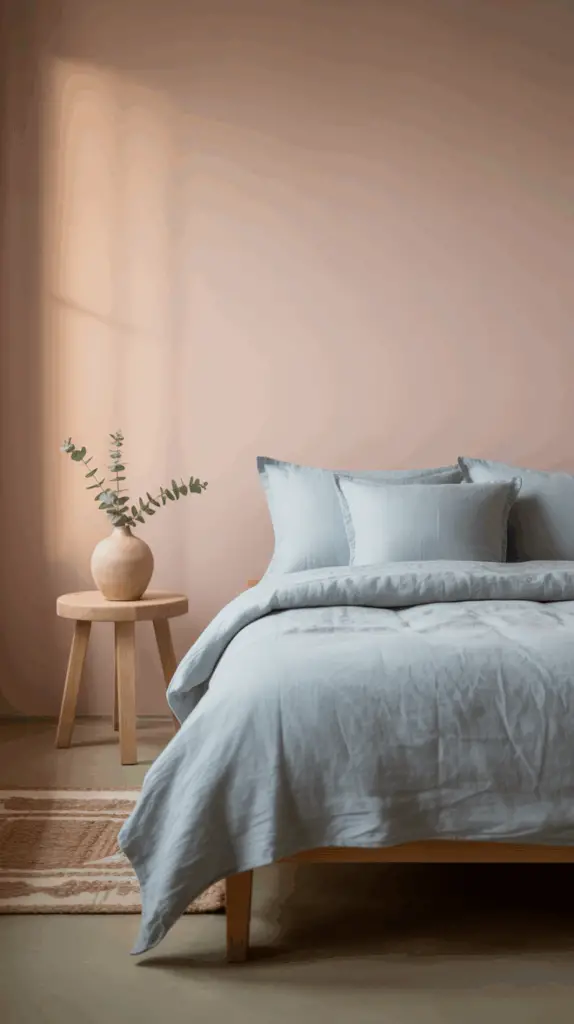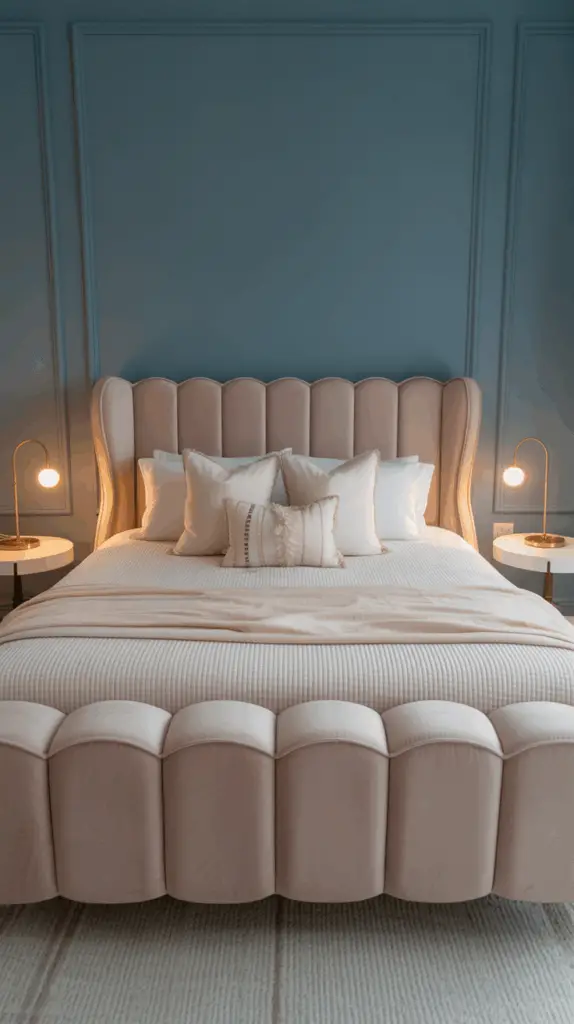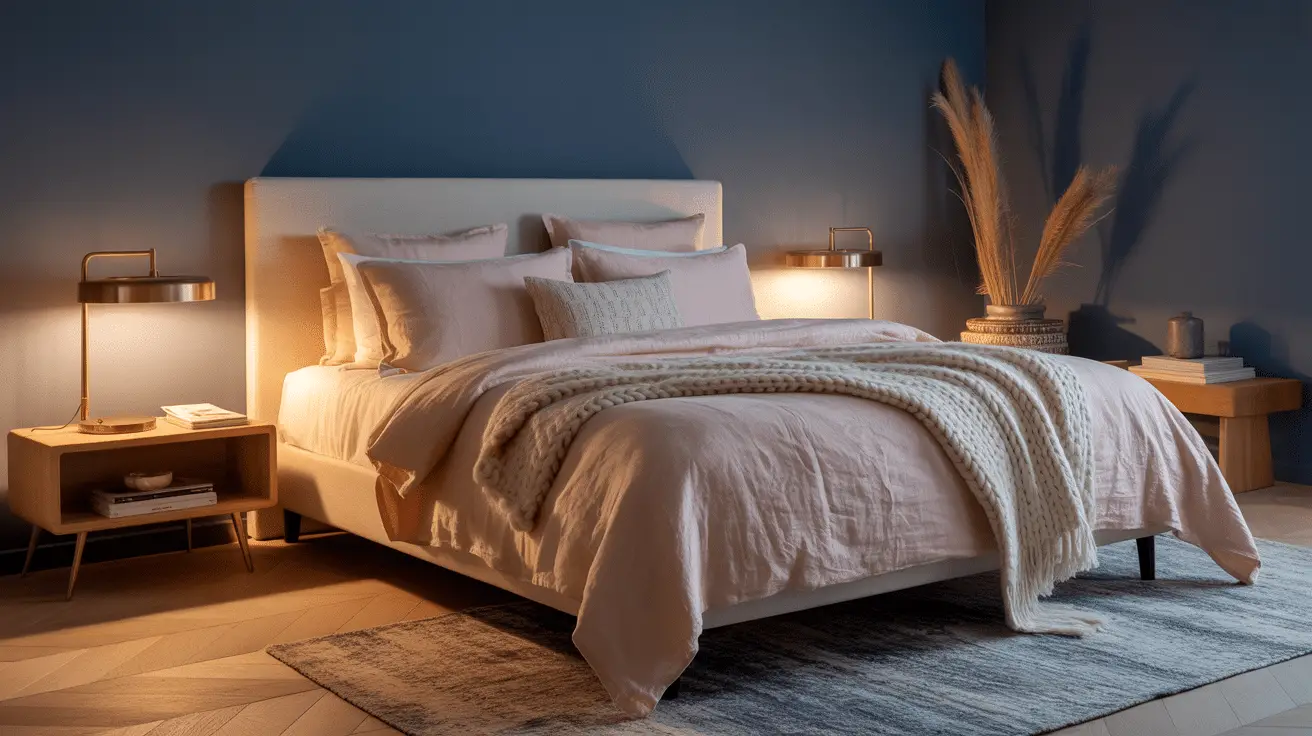How to Master a Blue and Pink Bedroom Combo for a Balanced, Stylish Space
Table of Contents
Why Blue and Pink Is the Power Duo Your Bedroom Needs
Blue and pink might sound like an unexpected match—one cool and calming, the other warm and lively—but when paired thoughtfully, they create one of the most balanced and visually captivating color combinations in interior design. According to recent color psychology trends, blue evokes peace and serenity while pink adds a dose of softness, playfulness, or romance, depending on the tone.
These two colors, though contrasting, can complement each other beautifully when used in harmony. They can make a bedroom feel fresh and modern, cozy and inviting, or even bold and artistic. The key lies in understanding tone, proportion, texture, and how light interacts with the shades you choose.
In this post, we’ll explore how to master the blue and pink bedroom combo like a professional designer. Whether you’re drawn to dusky blush and navy for a mature palette, or love pastel pinks with powdery blues for a light and dreamy atmosphere, you’ll find actionable tips for color pairing, layering textures, choosing the right furniture, playing with lighting, and accessorizing to complete the look.
Let’s transform your bedroom into a cohesive sanctuary where cool meets warm, and calm meets charm.
Finding the Right Blue and Pink Color Pairing for Your Style
The success of a blue and pink bedroom starts with selecting the right shades. These two colors exist on broad spectrums—from soft pastels to rich jewel tones—so it’s essential to match tones that work harmoniously.
For a sophisticated and timeless look, pair navy or indigo with a soft blush or muted rose. This combination grounds the room while keeping it gentle and modern. If you prefer a lighter, airier feel, pastel pink with powder blue or sky blue offers a whimsical, romantic vibe that works beautifully in smaller spaces or Scandinavian-inspired settings.
Bolder designs might combine hot pink with deep turquoise or peacock blue for a striking, eclectic energy. Regardless of your chosen palette, ensure one color leads while the other supports.
Table: Blue and Pink Pairings by Interior Mood
| Mood/Style | Blue Shade | Pink Shade | Vibe Description |
| Sophisticated Classic | Navy, Indigo | Blush, Dusty Rose | Elegant, grounded, calm |
| Soft & Feminine | Sky Blue, Powder Blue | Baby Pink, Shell | Airy, romantic, delicate |
| Bold & Playful | Turquoise, Cobalt | Hot Pink, Fuchsia | Vibrant, energetic, creative |
| Minimalist Modern | Slate Blue, Steel Blue | Pale Blush, Mauve | Understated, contemporary, clean |
| Eclectic Boho | Teal, Ocean Blue | Coral, Peach Pink | Warm, global-inspired, textural |
Balancing Proportions: Letting One Color Lead
When working with two strong colors like blue and pink, it’s vital to strike the right balance. Allowing one to dominate while the other supports helps avoid visual clutter or clashing tones. A simple 70-30 or 60-40 rule works beautifully.
Choose the primary color based on what you want the room to feel like. Blue, being cooler and more serene, is ideal as a dominant color if you’re aiming for a restful, soothing atmosphere. Pink, especially in its softer forms, works wonderfully as an accent to warm up blue’s coolness.
Let blue lead through larger surfaces like walls, area rugs, or bed linens, while pink can appear in throw pillows, artwork, or decorative accessories. Or flip the script for a warmer, more romantic tone—think dusty pink walls with navy bedding.
Table: Color Balance Techniques for Harmony
| Color Lead | Where to Use It | Secondary Color Usage |
| Blue Dominant | Walls, rug, bedding base, curtains | Accent pillows, artwork, lamps |
| Pink Dominant | Upholstered bed frame, wall color | Bedding layers, throw blankets |
| Equal Balance | Split bedding and accessories evenly | Use neutrals to break intensity |
| Neutral Base | Beige or white walls, wooden furniture | Use both colors in textiles/art |

Furniture Choices to Complement Your Blue and Pink Palette
Once your color palette is set, the next step is choosing furniture that aligns with your chosen tones while enhancing the overall mood of the room. Neutral-toned furniture is often the most versatile—think warm oak, rattan, whitewashed wood, or matte black metal.
For a blue-led space, opt for light wood or upholstered furniture in white, ivory, or pale grey to offset the coolness and create warmth. If pink is dominant, consider charcoal grey, cream, or walnut for a grown-up finish.
Upholstered bed frames in soft blush velvet or navy linen can serve as stunning focal points. Avoid shiny, reflective finishes and opt for matte or textured surfaces that echo the softness of your palette.
Table: Furniture Material & Color Pairings by Palette
| Dominant Color | Recommended Furniture Material | Best Furniture Colors | Why It Works |
| Blue | Wood, linen, metal | Light oak, whitewashed, ivory | Adds warmth and prevents coldness |
| Pink | Velvet, wood, brass | Walnut, brass, charcoal grey | Creates contrast and sophistication |
| Balanced | Rattan, cane, birch wood | Soft neutrals, warm greys | Keeps palette cohesive and subtle |

Lighting Design That Enhances Your Color Palette
Lighting doesn’t just illuminate a room—it amplifies its mood and reveals how your chosen colors behave. A blue and pink bedroom benefits from warm, ambient lighting that softens the contrast between cool and warm tones.
Start with warm white light bulbs (2700K–3000K) in bedside lamps, wall sconces, or overhead fixtures. Avoid cool-toned lighting, which can make pinks look too sterile and blues feel icy. Opt for fabric or frosted glass shades to diffuse light gently and evenly.
Statement fixtures in brass, matte black, or rattan can enhance the boho, vintage, or modern vibes of the space, depending on your styling. Don’t forget decorative lighting—string lights, salt lamps, or LED strip lighting behind headboards can subtly add to the ambience.
Table: Lighting Tips for a Blue and Pink Bedroom
| Light Source Type | Recommended Fixture Style | Lighting Tone | Design Effect |
| Overhead Light | Fabric drum, brass chandelier | Warm white (2700K) | General ambient glow |
| Bedside Lamps | Ceramic or linen shade lamps | Soft white (2800K–3000K) | Cozy, flattering light |
| Accent/Wall Lights | Rattan sconces, LED strips | Warm LED | Mood-enhancing, layered glow |
| Decorative Lighting | Fairy lights, lanterns, candles | Warm, dimmable | Adds charm and softness |
Textiles and Accessories That Tie the Look Together
The finishing touches—rugs, curtains, cushions, and accessories—are what truly bring a blue and pink bedroom to life. Layering is essential to build comfort, visual interest, and cohesion.
Start with a foundational rug that features hints of both colors or choose a neutral base that allows furniture and bedding to shine. Layer with pillows in varying shades of pink and blue, using a mix of velvet, linen, and cotton for tactile variety.
Curtains in a sheer blush or soft grey-blue tone help filter natural light without overwhelming the space. Artwork, vases, books, and candles in complementing colors further reinforce your palette without overdoing it.
Include metallic accents sparingly—brass and matte gold work beautifully with both blue and pink without clashing. A simple mirror with a warm frame or a few ceramic objects in mixed glazes can finish the room gracefully.
Table: Accessory Combinations for a Balanced Finish
| Accessory Type | Color/Textile Options | How It Enhances the Design |
| Pillows & Throws | Velvet, knit, cotton in pink/blue | Adds depth and softness |
| Curtains | Linen or sheer blend | Filters light, adds elegance |
| Rugs | Neutral with color flecks | Grounds and defines the space |
| Wall Art | Abstract in blush/navy tones | Pulls palette together |
| Decor Items | Matte ceramics, brass frames | Adds charm and subtle luxury |
Creative Layout Tips for a Harmonious Bedroom Flow
A well-designed bedroom balances style with comfort and function. When working with a dual-color palette, layout matters even more—it affects how the colors are perceived and how they interact with light and furniture.
Place your focal color—usually the darker one—behind the bed to anchor the space. For example, a navy blue accent wall behind a blush bed creates drama and focus. Keep lighter shades in peripheral areas like side walls or soft furnishings to avoid crowding the visual field.
Symmetry around the bed adds a sense of calm. Use matching lamps or tables to reinforce this, especially in a romantic or serene setting. Leave breathing space between larger furniture items to maintain openness, particularly in smaller rooms.
Mirrors placed opposite windows can bounce light and amplify color softness, while open shelving or ledges allow you to change up accents seasonally without major redecorating.
Table: Layout Strategies for a Balanced Blue and Pink Bedroom
| Design Element | Layout Suggestion | Benefit to Space and Color |
| Focal Wall | Use dominant color behind bed | Anchors the palette visually |
| Symmetry | Pair lamps or tables | Creates calm and order |
| Open Corners | Avoid over-furnishing | Keeps space light and breathable |
| Mirror Placement | Reflect natural light strategically | Enhances softness and depth |
| Floating Shelves | Style with decor in both tones | Flexible visual layering |
Conclusion: Bringing Balance, Beauty, and Personality to Your Blue and Pink Bedroom
Mastering the blue and pink bedroom combo is about more than just choosing two colors—it’s about curating a visual story that feels intentional, expressive, and calming. By finding the right tone pairing, establishing color balance, selecting complementary furniture, and layering with thoughtful lighting and accessories, you create a space that’s as beautiful as it is functional.
Whether you lean toward blush and navy, pastel and powder blue, or more daring contrasts, the key is harmony. Let the colors interact naturally, supported by textures and light, and let your own personality shine through in the details. The result? A bedroom that feels personal, polished, and perfectly styled.

